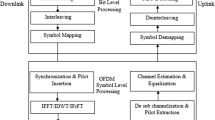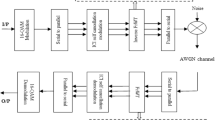Abstract
Wireless systems and standards are now progressing toward the implementation of fifth generation (5G) to combat with an expected and explosive growth of demands of wireless services in future. Consequently, wireless interoperability for microwave access (WiMAX) with orthogonal frequency division multiplexing (OFDM) technology at its physical layer is being utilized for the uplink and downlink transmission to afford the high spectral efficiency in fading environments. However, the 5G implementation requires additional improvements to meet the futuristic stress. This work proposes an innovative solution that combines WiMAX system with multiple input multiple output (MIMO) technology to meet the required elevated data rates as desired by the growing application needs of 5G. MIMO is capable to fulfil the vision of 5G to realize a huge number of base stations equipped with a large number of terminals to be served in the same time-frequency resource without severe inter-user interference. Furthermore, the proposed system is demonstrated incorporation with discrete wavelet transform (DWT), and fractional Fourier transforms (FrFTs) in the physical layer of the WiMAX system. The evaluated outcomes exemplify a considerable improvement in bit error rate (BER) performance in contrast with the earlier reported work.
Similar content being viewed by others
References
Banelli P, Buzzi S, Colavolpe G, Modenini A, Rusek F, Ugolini A. Modulation formats and waveforms for 5G networks: who will be the heir of OFDM?: an overview of alternative modulation schemes for improved spectral efficiency. IEEE Signal Processing Magazine, 2014, 31(6): 80–93
Li Y, Winters J H, Sollenberger N R. MIMO-OFDM for wireless communications: signal detection with enhanced channel estimation. IEEE Transactions on Communications, 2002, 50(9): 1471–1477
IEEE 802.16a. Local and Metropolitan Area Networks—Part 16, Air Interface for Fixed Broadband Wireless Access Systems. IEEE Standard, 2004
IEEE 802.11a. Part 11: Wireless LAN Medium Access Control (MAC) and Physical Layer (PHY) Specifications: High-Speed Physical Layer in the 5 GHz Band. IEEE Standard, 1999
Suthaharan S, Nallanathan A, Kannan B. Space-time coded MIMOOFDM for high capacity and high data-rate wireless communication over frequency selective fading channels. In: Proceedings of International Workshop on Mobile and Wireless Communications. Stockholm: IEEE, 2002, 424–428
Alamouti S. A simple transmit diversity technique for wireless communications. IEEE Journal on Selected Areas in Communications, 1998, 16(8): 1451–1458
Tashiro K, Lanante L Jr, Kurosaki M, Ochi H. High-resolution image transmission over MIMO-OFDM E-SDM system with JSCC. In: Proceedings of IEEE Fourth International Conference on Consumer Electronics Berlin (ICCE-Berlin). Berlin: IEEE, 2014, doi: 10.1109/ICCE-Berlin.2014.7034243
Tarokh V, Jafarkhani H, Calderbank A R. Space-time block codes from orthogonal designs. IEEE Transactions on Information Theory, 1999, 45(5): 1456–1467
Tarokh V, Seshadri N, Calderbank A R. Space-time codes for high data rate wireless communication: performance criterion and code construction. IEEE Transactions on Information Theory, 1998, 44 (2): 744–765
Gupta D, Vats V B, Garg K K. Performance analysis of DFTOFDM, DCT-OFDM, and DWT-OFDM systems in AWGN channel. In: Proceedings of International Conference on Wireless and Mobile Communications. Athens: IEEE, 2008, 214–216
Hamid Z A, Samir M, Abd El-atty S M, El-Hennawy A E, El Shenawy H, Alshebeili S A, Abd El-Samie F E. On the performance of FFT/DWT/DCT-based OFDM systems with chaotic interleaving and channel estimation algorithms. Wireless Personal Communications, 2014, 78(2): 1495–1510
Lakshmanan M K, Nikookar H. A review of wavelets for digital wireless communication. Wireless Personal Communications, 2006, 37(3-4): 387–420
Zhang X D, Xu P P, Zhang G A, Bi G G. Study on complex wavelet packet based OFDM modulation (CWPOFDM). Chinese Journal of Electronics, 2002, 30(4): 477–479
Sejdic E, Djurovic I, Stankovic L. Fractional Fourier transform as a signal processing tool: an overview of recent developments. Signal Processing, 2011, 91(6): 1351–1369
Molteni D, Nicoli M, Spagnolini U. Performance of MIMOOFDMA systems in correlated fading channels and non-stationary interference. IEEE Transactions on Wireless Communications, 2011, 10(5): 1480–1494
Abdullah K, Sadik A Z, Hussain Z M. On the DWT-and WPTOFDM versus FFT-OFDM. In: Proceedings of 5th IEEE GCC Conference & Exhibition. Kuwait City: IEEE, 2009, 1–5
Asif R, Abd-Alhameed R A, Oanoh O, Dama Y, Migdadi H S, Noars J M, Hussaini A S, Rodriquez J. Performance comparison between DWT-OFDM and FFT-OFDM using time domain zero forcing equalization. In: Proceedings of 2012 International Conference on Telecommunication and Multimedia. Chania: IEEE, 2012, 175–179
Sharma V, Singh G. On BER assessment of conventional-and wavelet-OFDM over AWGN channel. Optik (Stuttgart), 2014, 125 (20): 6071–6073
Kumbasar V, Kucur O. Performance comparison of wavelet based and conventional OFDM systems in multipath Rayleigh fading channels. Digital Signal Processing, 2012, 22(5): 841–846
Kansal A, Singh K, Saxena R. FrFT based OFDM system for Wireless Communications. International Journal of Engineering Science, 2014, 10(6): 43–48
Kansal A, Singh K, Saxena R. Performance analysis of FrFT based OFDM system with 1024-PSK and 1024-QAM modulation under various wireless fading channels. International Journal of Systems Assurance, Engineering and Management, 2017, 8(supplement 1): 137–145
Kansal A, Singh K, Saxena R. Bit error rate analysis of FrFT appended OFDM system. Optik (Stuttgart), 2015, 126(7–8): 715–718
Vieira J, Malkowsky S, Nieman K, Miers Z, Kundargi N, Liu L, Wong I, Owall V, Edfors O, Tufvesson F. A exible 100-antenna testbed for massive MIMO. In: Proceedings of IEEE Global Communications Conference (GLOBECOM) Workshop on Massive MIMO: From Theory to Practice. Austin, TX: IEEE, 2014, 287–293
Kim Y, Ji H, Lee J, Nam Y H, Ng B L, Tzanidis I, Li Y, Zhang J. Full dimension MIMO (FD-MIMO): the next evolution of MIMO in LTE systems. IEEEWireless Communications, 2014, 21(3): 92–100
Ge X, Huang K, Wang C X, Hong X, Yang X. Capacity analysis of a multi-cell multi-antenna cooperative cellular network with cochannel interference. IEEE Transactions on Wireless Communications, 2011, 10(10): 3298–3309
Ge X, Wang H, Zi R, Li Q, Ni Q. 5G multimedia massive MIMO communications systems. Wireless Communications and Mobile Computing, 2016, 16(11): 1377–1388
Ge X, Zi R, Wang H, Zhang J, Jo M. Multi-user massive MIMO communication systems based on irregular antenna arrays. IEEE Transactions onWireless Communications, 2016, 15(8): 5287–5301
Spencer Q H, Peel C B, Swindlehurst A L, Haardt M. An introduction to the multi-user MIMO downlink. IEEE Communications Magazine, 2004, 42(10): 60–67
Kansal L, Sharma V, Singh J. BER assessment of FFT-OFDM against WHT-OFDM over different fading channels. Wireless Networks, 2017, 23(7): 2189–2196
Kansal L, Sharma V, Singh J. Performance evaluation of FFTWiMAX against WHT-WiMAX over Rayleigh fading channel. Optik (Stuttgart), 2016, 127(10): 4514–4519
Author information
Authors and Affiliations
Corresponding author
Additional information
Lavish Kansal is a passionate researcher in the field of wireless communication. He received his B.Tech degree in Electronics and Communication Engineering from PTU, Jalandhar in 2009 and M.E. degree in Electronics and Communication Engineering from Thapar University, Patiala in 2011. He is currently pursuing his Ph.D. from IKG PTU Jalandhar. He is working as Assistant Professor in the School of Electronics and Electrical Engineering, Lovely Professional University, Phagwara, India. He has published over 65 papers in refereed journals and conferences (India and Abroad). His research area includes digital signal processing, digital communication & wireless communication.
Dr. Vishal Sharma is presently working as Associate Professor in the Department of Electronics and Communication Engineering at Shaheed Bhagat Singh State Technical Campus, Ferozepur, Punjab (India). He received his M.Tech. and Ph.D. degrees in Electronics and Communication Engineering. He has published over 84 papers in refereed journals and conferences (India and Abroad). He has affiliation with various program committees for different International/National Conferences and is on the review board of various International journals of repute. His area of curiosity is integrated optical and wireless communication systems.
Dr. Jagjit Singh Malhotra is a passionate researcher in the field of optical and wireless communication. He started his career as Lecturer in 1994 and is now working as Associate Professor and in Department of Electronics and Communication Engineering at DAV Institute of Engineering & Technology, Jalandhar. His current research area is multichannel high capacity optical links and wireless networks. He has more than 45 papers of international research publications to his credit and has authored 4 books.
Rights and permissions
About this article
Cite this article
Kansal, L., Sharma, V. & Malhotra, J.S. MIMO-WiMAX system incorporated with diverse transformation for 5G applications. Front. Optoelectron. 12, 296–310 (2019). https://doi.org/10.1007/s12200-018-0841-x
Received:
Accepted:
Published:
Issue Date:
DOI: https://doi.org/10.1007/s12200-018-0841-x




